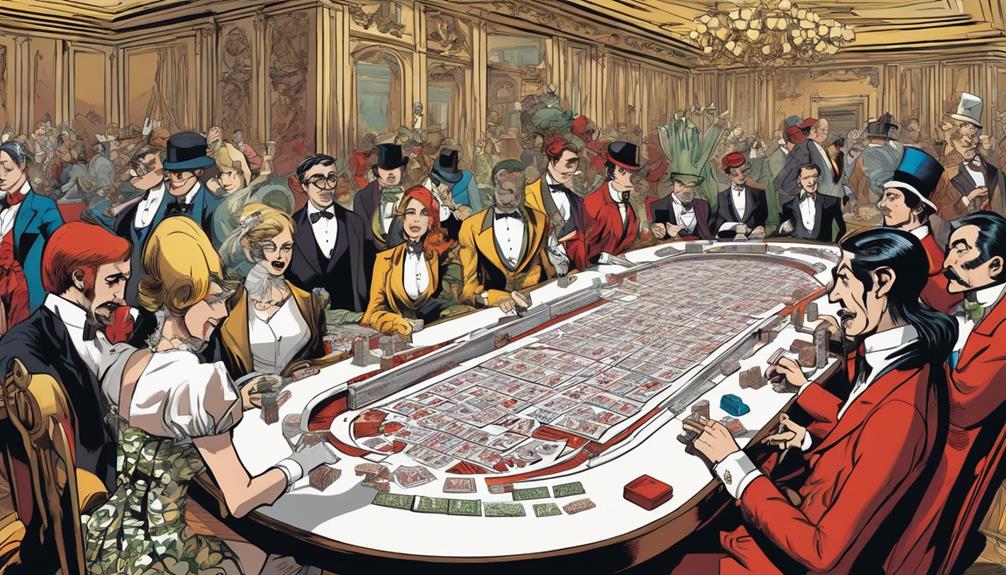When examining the baccarat variants Chemin De Fer and Punto Banco, intricate disparities in gameplay mechanics, betting choices, and strategic involvement become apparent, leading to distinctive player engagements and impacting considerations of the house edge. Each variant offers a unique experience, from the competitive player dynamics of Chemin De Fer to the simplified betting options of Punto Banco, showcasing diverse strategic considerations and opportunities for players to explore further nuances and enhancements in their gameplay.
Key Takeaways
- Chemin de Fer involves players competing against each other, while Punto Banco simplifies by betting on banker, player, or tie.
- Player bet advantages in both games differ, with Chemin de Fer offering a lower house edge and higher payouts.
- The role of the banker varies, with players taking on the role in Chemin de Fer and the casino as the permanent banker in Punto Banco.
- Betting options differ, with Chemin de Fer allowing challenges to the banker with ‘Banco’ and Punto Banco offering fixed betting choices.
- House edge varies between the two variants, with Punto Banco having a house edge on the banker bet while Chemin de Fer shows a lower house edge.
Origins and History

Chemin de Fer and Punto Banco stand as two distinct variants of baccarat, each with a rich historical background that sheds light on the evolution of this popular card game. Chemin de Fer means ‘iron road‘ in French, referencing the swift movement of the cards during gameplay. In this version, players take turns acting as the banker, adding a strategic element to the game.
On the other hand, Punto Banco, or North-American Baccarat, simplifies the game by always having the casino act as the banker. This variant gained popularity in the 1940s in Havana. The shift from Chemin de Fer to Punto Banco showcases how baccarat has adapted to different player preferences and styles over time, marking significant changes in its historical development.
Gameplay Mechanics Overview
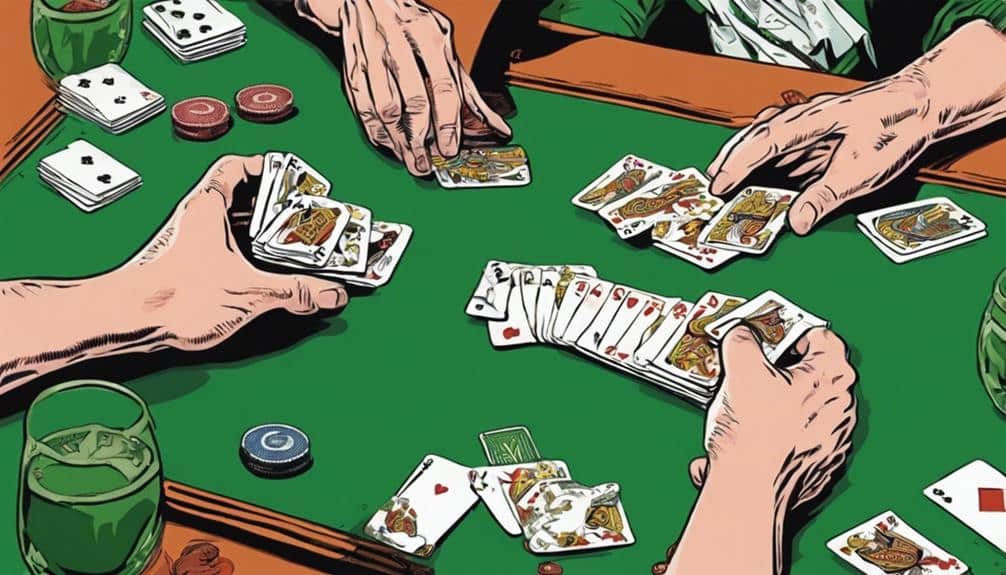
The gameplay mechanics of baccarat variants revolve around specific points, including the rules of play, betting options, and winning conditions.
Understanding these key elements is vital to mastering the nuances of each variant and making informed decisions during gameplay.
Rules of Play
In the domain of Baccarat variants, the gameplay mechanics offer distinct characteristics that differentiate Chemin de Fer from Punto Banco.
Chemin de Fer:
- Players compete against each other and can challenge the banker by saying ‘Banco.’
- Involves players shuffling cards and taking on the role of the banker, adding a unique dynamic to the game.
- Decision-making process is more player-driven, allowing for strategic gameplay.
Learn about the unique characteristics of Chemin de Fer vs Baccarat in this in-depth comparison guide.
Punto Banco:
- Simplified version where players bet on the banker, player, or a tie.
- Follows standardized rules with the casino always acting as the banker, offering a straightforward gameplay experience.
- Fixed drawing rules for both players and the banker ensure a consistent and predictable gaming environment.
Betting Options
Players in baccarat are presented with distinct betting options that vary between different variants of the game, influencing the strategic depth and interactive dynamics of their gameplay experience. In Chemin de Fer, players can challenge the banker by saying ‘Banco,’ adding a competitive dynamic to the game not found in Punto Banco. On the other hand, Punto Banco offers simplified betting options where players can wager on the Banker, Player, or Tie, providing a more straightforward gameplay experience. The table below summarizes the key betting options available in each variant:
| Betting Options | Chemin de Fer | Punto Banco |
|---|---|---|
| Bank | ✓ | ✓ |
| Player | ✓ | ✓ |
| Tie | – | ✓ |
In Chemin de Fer, players can engage in a more competitive and strategic gameplay by challenging the banker with the ‘Banco’ option, while Punto Banco offers a simpler and more standardized betting experience.
Winning Conditions
Comparing the betting options available in Chemin de Fer and Punto Banco provides a foundation for understanding the distinct winning conditions and gameplay mechanics of these baccarat variants.
Player Dynamics:
- In Chemin de Fer, players compete against each other, while in Punto Banco, players face the house.
Player Decision-Making:
- Chemin de Fer allows players to choose whether to stand or draw a third card, adding a strategic element.
Gameplay Simplification:
- Punto Banco offers a simplified version of baccarat with fixed drawing rules for both players and the house. The banker deals according to predetermined procedures, streamlining the gameplay towards determining the winning hand efficiently.
Role of the Banker
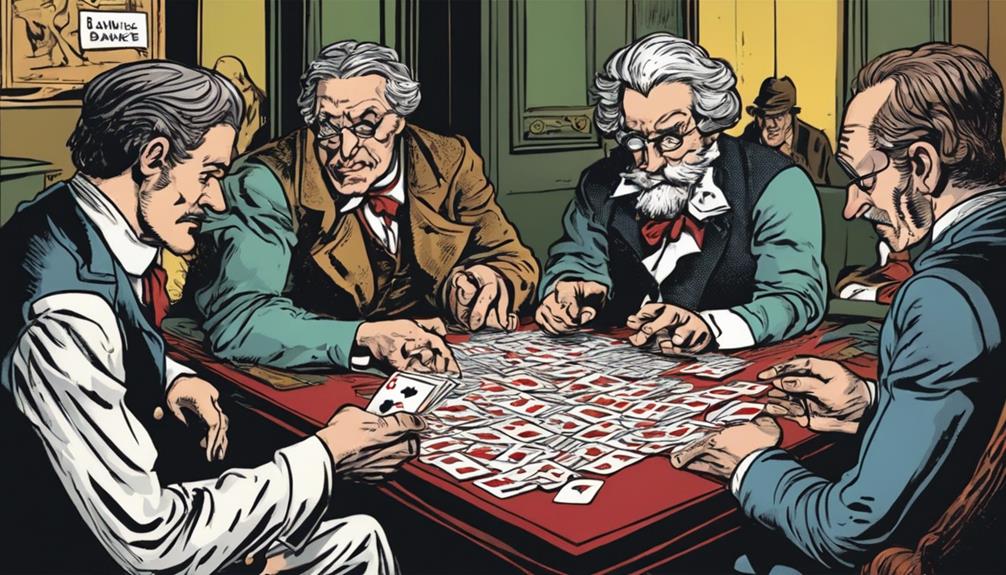
The pivotal role of the banker in Baccarat variants greatly influences the gameplay experience, shaping strategic decisions and gameplay dynamics.
In Chemin de Fer, players actively take on the role of the banker, allowing them to set the bets at risk and participate in dealing with the cards, adding a strategic layer to the game. Conversely, Punto Banco designates the casino as the permanent banker, simplifying the process and ensuring consistency in gameplay.
The dynamic nature of the banker in Chemin de Fer fosters interactive gameplay, where players must make decisions that impact the outcome directly. This interactive element adds depth and engagement to the game, contrasting with the streamlined approach of Punto Banco where the casino always assumes the role of the banker.
Player Betting Options

When evaluating the player betting options in different Baccarat variations, it is essential to analyze the benefits of placing bets on the player hand.
Moreover, investigating the availability of a tie bet option can offer insight into the risk-reward dynamics of each variant.
Contrasting the bet limits across various Baccarat games can further enrich players’ comprehension of their wagering choices.
Player Bet Advantages
Offering players a strategic advantage, the Player bet in both Chemin de Fer and Punto Banco presents a compelling betting option with lower house edges and the potential for higher payouts.
Betting on the Player hand provides more flexibility in wagering and actively involves players in the game’s outcome. The lower house edge associated with the Player bet enhances the chances of winning and makes it an attractive choice for those seeking a more engaging experience.
Additionally, opting for the Player hand can lead to more substantial payouts compared to Tie bets, adding to the overall appeal of this betting option in both variants.
- Lower house edge
- Flexibility in betting
- Higher payouts
Tie Bet Option
Introducing another intriguing aspect of player betting options in Baccarat variants, the inclusion or exclusion of the tie bet option significantly influences the gameplay dynamics and risk-reward balance for participants. In Chemin de Fer, players can choose to bet on a tie between the banker and player hands, offering higher payouts but carrying a higher house edge. This option adds an element of excitement and risk, appealing to those who enjoy higher-risk wagers.
On the other hand, Punto Banco simplifies the betting choices by not including the tie bet option, focusing solely on the banker and player hand outcomes. The absence of tie bets in Punto Banco streamlines the game and eliminates the complexities associated with this specific wager, providing a more straightforward experience for players.
Bet Limits Comparison
The comparison of bet limits in Chemin de Fer and Punto Banco highlights the distinct approaches to player betting options in these Baccarat variants.
In Chemin de Fer, players have wagering flexibility, being able to select their stake amounts and match the banker’s bet with a ‘Banco’ wager.
Punto Banco, on the other hand, offers predefined choices with fixed limits, limiting player options to betting on the banker, player, or tie.
Chemin de Fer provides an element of strategy as players can adjust their stake amounts based on their confidence in winning, contrasting with Punto Banco’s rigid structure that restricts player control over betting options.
Tie Bet Considerations
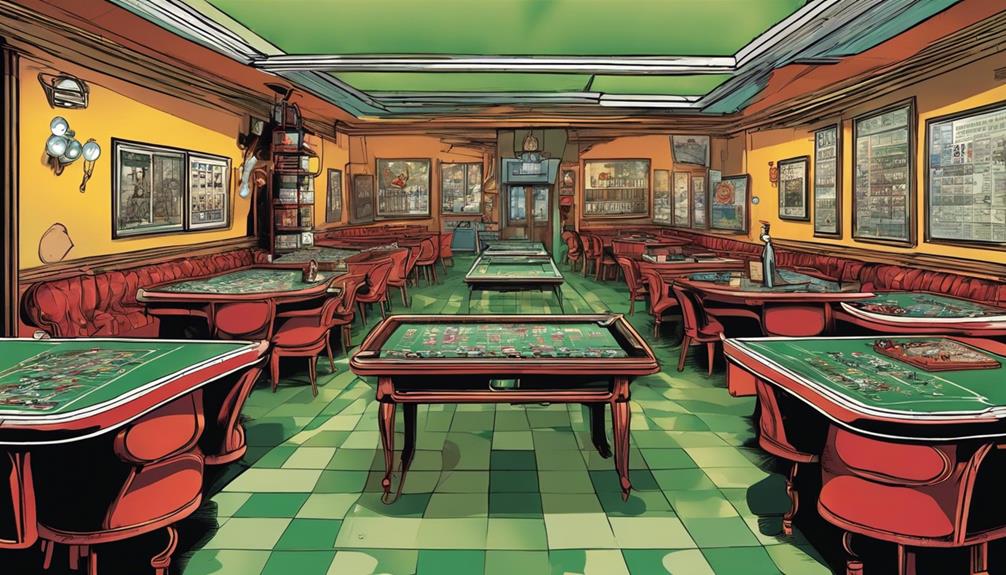
Considering the tie bet in Baccarat variants presents players with contrasting wagering options and associated risks. In Punto Banco, players have the opportunity to bet on a tie outcome, which typically offers higher payouts than player or banker bets. However, it is important to note that this higher reward comes with a higher house edge, making it a riskier wager.
On the other hand, Chemin de Fer does not include the option to bet on a tie during gameplay. This variant emphasizes player interactions and strategic gameplay over the simpler betting structure found in Punto Banco, where the tie option is available.
Understanding the implications of the tie bet is imperative for players looking to make informed decisions in their Baccarat gameplay.
Strategy and Skill Differences
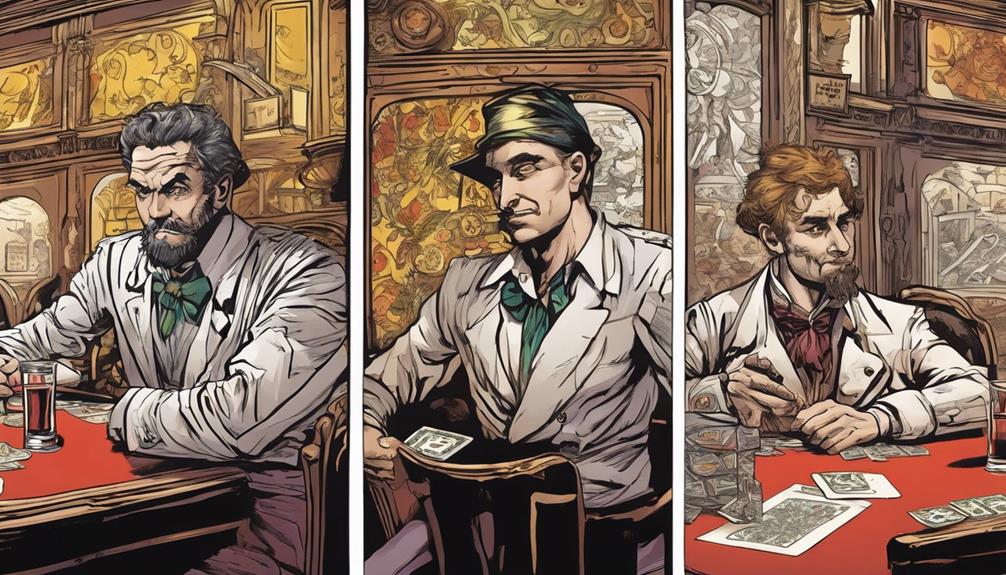
A distinguishing feature between Chemin de Fer and Punto Banco lies in the depth of strategy and skill required by players in each variant.
- Player Control and Decision-making: In Chemin de Fer, players have more control over their decisions compared to the more standardized rules of Punto Banco.
- Influence on Game Dynamics: Strategy has a major impact on Chemin de Fer outcomes, allowing players to influence the game by choosing when to act as the banker, a feature absent in Punto Banco.
- Nuances and Interaction: Understanding player behavior and predicting moves is important in Chemin de Fer, adding an interactive element and requiring a deep understanding of the game’s subtleties, making it more complex and engaging compared to the straightforward nature of Punto Banco.
House Edge Variances

When considering House Edge Variances in baccarat variants, it is essential to grasp the fundamental concepts of House Edge basics, the impact of rules, and various betting strategies.
These points serve as the foundation for understanding how different rules and strategies can influence the advantage the house holds in each variant.
House Edge Basics
Understanding the nuances of house edge variations in baccarat variants is essential for informed decision-making when placing bets.
- Punto Banco: The house edge on the banker bet is approximately 1.06%, while the player bet carries a house edge of around 1.24%.
- Chemin de Fer: Typically offers a lower house edge compared to Punto Banco due to the player-dealt nature of the game.
- Number of Decks: Punto Banco’s house edge variations are primarily influenced by the number of decks used, impacting the odds slightly.
Recognizing the impact of house edge differences between Chemin de Fer and Punto Banco is vital for making well-informed betting decisions in various baccarat variants. Players should consider the house edge, player-dealt aspect, and the number of decks used when strategizing their gameplay.
Impact of Rules
The impact of rules on house edge variances in baccarat variants is a critical factor influencing players’ strategic decisions and outcomes. Punto Banco, with its standardized rules, typically boasts a lower house edge compared to Chemin de Fer.
In Chemin de Fer, the variable house edge is influenced by player decisions, particularly when a player acts as the banker. This variant’s house edge can fluctuate based on the strategies employed during gameplay.
Conversely, Punto Banco offers a more predictable house edge due to its fixed drawing rules, which eliminate player-influenced dynamics. Understanding these distinctions is essential for players seeking to optimize their gameplay and make informed choices in selecting between the two variants.
Betting Strategies
Analyzing betting strategies in baccarat variants reveals essential insights into how house edge variances impact player decision-making and gameplay outcomes.
- Player Bet: In Punto Banco, the player bet carries a house edge of approximately 1.24%.
- Banker Bet: The banker bet in Punto Banco has a lower house edge of around 1.06%.
Dynamic Gameplay: Chemin de Fer allows players to make strategic decisions, influencing the game’s outcome and potentially reducing the house edge, creating a more dynamic and engaging gameplay experience.
Understanding the nuances of house edge variations between Punto Banco and Chemin de Fer is vital for players looking to optimize their betting strategies and enhance their overall gameplay experience based on their preferred level of strategic involvement.
Popularity and Global Reach
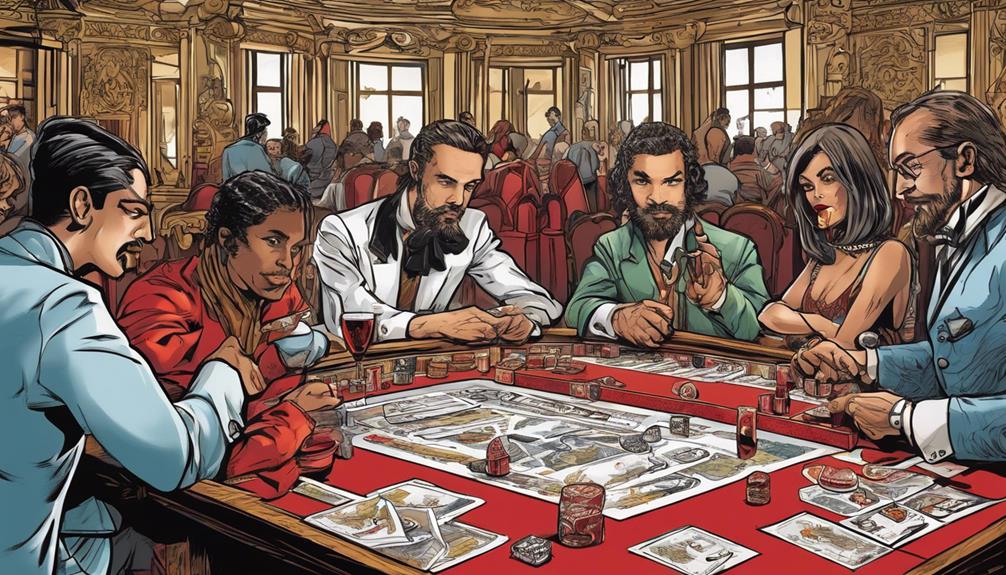
With a strong foothold in North America and a global player base, Punto Banco emerges as the most prevalent and widely favored variant of baccarat. Its simplified version, standardized rules, and global presence have made it a popular choice among players worldwide.
In contrast, Chemin de Fer, known for its traditional gameplay and player-banker dynamics, is more commonly found in European casinos and attracts high-stakes players seeking a strategic and interactive baccarat experience.
While both variants enjoy a global presence, Punto Banco’s simplicity has propelled its popularity in mainstream casinos, appealing to a broader audience. On the other hand, Chemin de Fer remains a favorite among purists and enthusiasts looking for a more traditional and engaging baccarat gameplay.
Notable Variants Comparison

An in-depth analysis of the key differences between Chemin de Fer and Punto Banco baccarat variants reveals distinct gameplay dynamics and strategic elements that cater to diverse player preferences.
- Chemin de Fer involves players competing against each other with a rotating banker position, fostering player interaction and strategic gameplay.
- Punto Banco features a fixed banker position held by the casino, offering a more standardized experience with less player involvement in the banking aspect.
- Strategy plays a significant role in Chemin de Fer, where players can choose to match the bank’s stake, while Punto Banco simplifies the gameplay by having the casino always act as the banker, providing a consistent gameplay experience.
Future Trends and Innovations
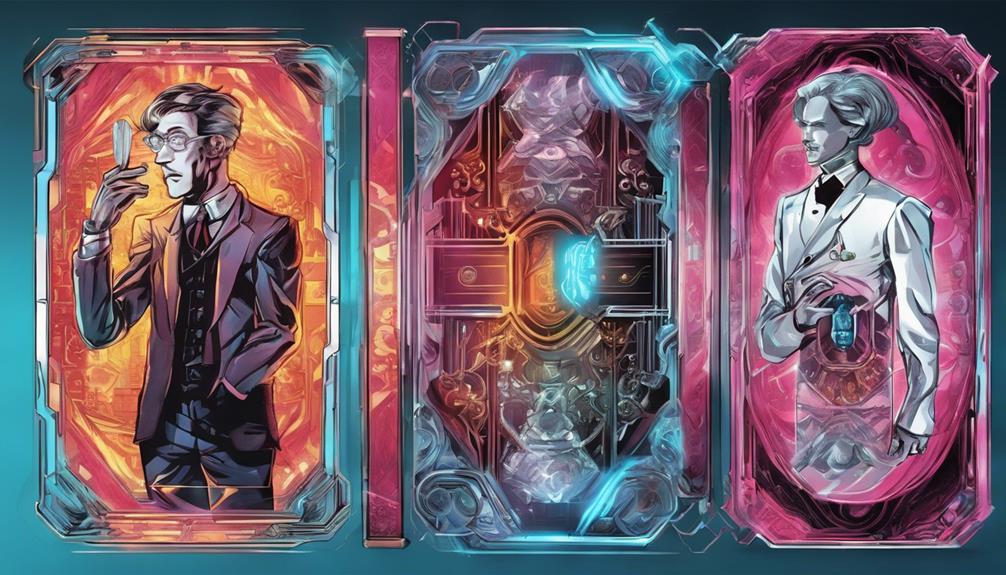
What potential advancements in technology and player preferences could shape the future landscape of both Chemin de Fer and Punto Banco baccarat variants?
The rise of online platforms offering live dealer versions caters to modern preferences, with possibilities for further immersive experiences through virtual reality. Integration of blockchain technology and cryptocurrencies could enhance security and transparency in gameplay. AI-driven algorithms and data analytics may optimize player strategies. Hybrid versions merging elements of both games could attract a broader audience.
Additionally, emerging social trends will likely influence the development of these variants. As technology continues to advance, these innovations are poised to reshape the baccarat landscape, offering players new and enhanced ways to enjoy these traditional games.
Explore the chances of amassing wealth through the game in our detailed guide on Winning Big at Baccarat: Can You Get Rich?
Conclusion
To sum up, chemin de fer and punto banco are two popular variants of the game of baccarat with distinct gameplay mechanics and betting options.
The role of the banker, house edge variances, and global popularity all contribute to the differences between these variants.
Despite their similarities, players should be aware of the unique features and odds associated with each variant before making their betting decisions.
Future trends and innovations in baccarat may continue to shape the evolution of these games.

